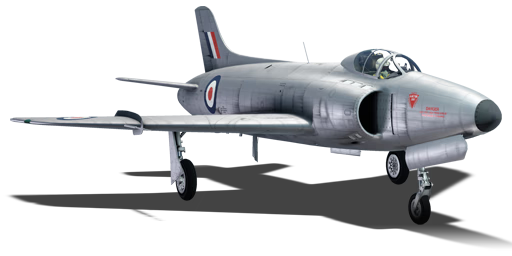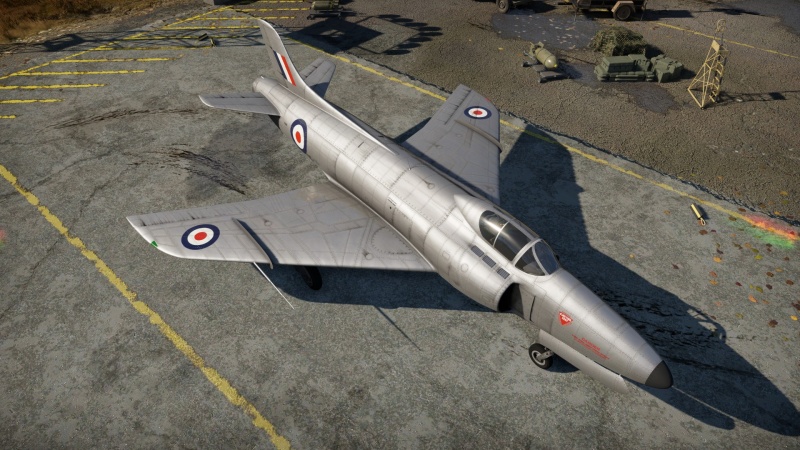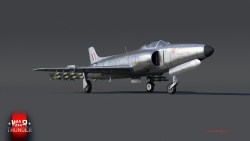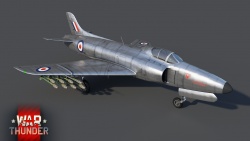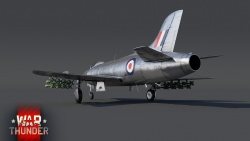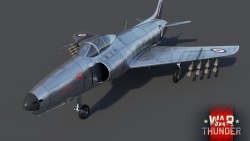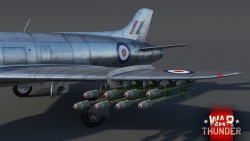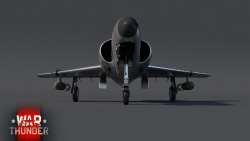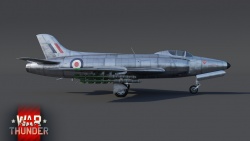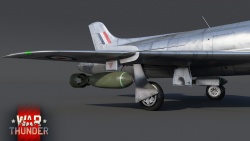Difference between revisions of "Swift F.1"
(Edits) |
(→Details) |
||
| Line 59: | Line 59: | ||
! Combat !! Take-off !! Landing !! + !! - | ! Combat !! Take-off !! Landing !! + !! - | ||
|- | |- | ||
| − | | {{Specs|destruction|body}} || {{Specs|destruction|gear}} || N/A || 1,035 || 465 || ~9 || ~5 | + | | 1,186 <!-- {{Specs|destruction|body}} --> || {{Specs|destruction|gear}} || N/A || 1,035 || 465 || ~9 || ~5 |
|- | |- | ||
|} | |} | ||
Revision as of 15:11, 30 November 2022
| This page is about the British jet fighter Swift F.1. For the other version, see Swift F.7. |
Contents
Description
The Swift F.1 is a rank British jet fighter with a battle rating of (AB), (RB), and (SB). It was introduced in Update 1.91 "Night Vision".
General info
Flight performance
| Characteristics | Max Speed (km/h at 3,048 m) |
Max altitude (metres) |
Turn time (seconds) |
Rate of climb (metres/second) |
Take-off run (metres) | |||
|---|---|---|---|---|---|---|---|---|
| AB | RB | AB | RB | AB | RB | |||
| Stock | 982 | 980 | 26.6 | 27.2 | 19.3 | 16.7 | 850 | |
| Upgraded | 989 | 985 | 23.5 | 25.0 | 37.7 | 28.0 | ||
Details
| Features | |||||
|---|---|---|---|---|---|
| Combat flaps | Take-off flaps | Landing flaps | Air brakes | Arrestor gear | Drogue chute |
| X | ✓ | ✓ | X | X | X |
| Limits | ||||||
|---|---|---|---|---|---|---|
| Wings (km/h) | Gear (km/h) | Flaps (km/h) | Max Static G | |||
| Combat | Take-off | Landing | + | - | ||
| 1,186 | N/A | 1,035 | 465 | ~9 | ~5 | |
| Optimal velocities (km/h) | |||
|---|---|---|---|
| Ailerons | Rudder | Elevators | Radiator |
| < 850 | < 600 | < 600 | N/A |
Engine performance
| Engine | Aircraft mass | |||||
|---|---|---|---|---|---|---|
| Engine name | Number | Basic mass | Wing loading (full fuel) | |||
| Rolls-Royce Avon Mk.105 | 1 | 6,019 kg | 271 kg/m2 | |||
| Engine characteristics | Mass with fuel (no weapons load) | Max Takeoff Weight | ||||
| Weight (each) | Type | 7m fuel | 20m fuel | 23m fuel | ||
| 1,000 kg | Axial-flow turbojet | 6,525 kg | 7,452 kg | 7,705 kg | 9,530 kg | |
| Maximum engine thrust @ 0 m (RB/SB) | Thrust to weight ratio @ 0 m (100%) | |||||
| Condition | 100% | WEP | 7m fuel | 20m fuel | 23m fuel | MTOW |
| Stationary | 3,107 kgf | N/A | 0.48 | 0.42 | 0.40 | 0.33 |
| Optimal | 3,197 kgf (1,186 km/h) |
N/A | 0.49 | 0.43 | 0.41 | 0.34 |
Survivability and armour
- 50 mm thick bulletproof glass in cockpit windshield.
- 12.7 mm steel plate behind pilot.
- Most of the critical components positioned inside the fuselage (Pilot, engine and fuel tanks)
Modifications and economy
Armaments
Offensive armament
The Swift F.1 is armed with:
- 2 x 30 mm ADEN cannons, nose-mounted (200 rpg = 400 total)
Suspended armament
The Swift F.1 can be outfitted with the following ordnance:
- Without load
- 2 x 500 lb G.P. Mk.IV bombs (1,000 lb total)
- 2 x 1,000 lb G.P. Mk.I bombs (2,000 lb total)
- 2 x 1,000 lb M.C. Mk.I bombs (2,000 lb total)
- 16 x RP-3 rockets
Usage in battles
The Swift is a British subsonic jet fighter. The aircraft is considered by some users to be a "Mini Hunter" as the Swift shares a lot of strengths and weaknesses with the beast.
This jet's strengths consist of good acceleration, climb rate and top speed, which if used properly can make it a brutal 'Boom and Zoom' aircraft, as even a short burst from the dual ADEN 30 mm revolver cannons will shred anything unfortunate enough to be in the way. The jet also has good energy retention, allowing it to make a 'swift' getaway if the pilot doesn't manage to kill their target, as even in a gentle climb it does not bleed speed as fast as other jets of its tier.
The main weakness of the jet is that it is not very manoeuvrable, meaning that if caught in a sticky situation, the Swift is unlikely to be able to out-dogfight its opponent unless the pilot is very experienced. Try to escape a dogfight before it begins, but if you are forced to engage, avoid throwing the jet into any sort of tight horizontal manoeuvres as there are very few aircraft the Swift will out-turn and you will end up losing any energy you may have had, becoming a sitting duck for whoever decides to claim the kill. Instead, when manoeuvring take advantage of oblique and vertical planes as you will have much more control over your energy, as well as making it easier to search for an escape route. If you manage to escape a dogfight, extend out using the Swift's acceleration and get some distance, then you can decide whether to re-engage. Also, be careful in dives. The Swift is a fast plane and as such, in a full-on boom dive from the heavens, you are likely to be going at around 1,100 km/h (700 mph) IAS, which is great for taking out unaware enemies who haven't seen you. At this point, however, the Swift is at its least manoeuvrable, at this speed turning and pulling up takes a very long time, and many new Swift pilots will find themselves embedded in the nearest hillside after a dive, take the time to learn the limits of the plane and know when to pull up. The Swift also has no designed air brake, instead the jet is equipped with the strongest takeoff flaps in the game, which still manage to hold together at the top speed of the plane, they do a great job of ditching unwanted speed, even in a steep dive, so use them if you feel you are coming in too fast.
Another minor weakness of the Swift is the fact that the two ADENs fire very quickly, expending all 400 rounds in about 10 seconds, so in an extended battle you may find yourself clean out of bullets, at which point you'll either escape and rearm, or become a sitting duck for the nearest fully loaded transonic fighter who sees you.
To summarise, use the Swift as a 'Boom and Zoomer', avoid horizontal dogfights, watch your speed in dives, and make sure to keep an eye on your ammo count, do all this and you'll be sure to quickly get many kills under your belt.
Radars
The Swift F.1 is equipped with an AN/APG-30 rangefinding radar, located in the nose of the aircraft. It will automatically detect other planes within the scanning area and display the range to the closest target. It is linked with a gyro gunsight and can help with aiming at close range.
| AN/APG-30 - Rangefinding radar | |||
|---|---|---|---|
| Maximum Tracking Range |
Minimum Tracking Range |
Azimuth Tracking Angle |
Elevation Tracking Angle |
| 2,750 m | 300 m | ±9° | ±9° |
Pros and cons
Pros:
- Great acceleration, climb rate and high top speed
- Decent energy retention, but not the best at it (especially against MiG-15/17)
- Fast firing 30 mm ADEN cannons
- MC 1,000 lb bombs and RP-3 rockets available for light CAS roles
- Very responsive airframe both on roll and instant turning
- Take-off flaps have a high rip speed and can work as airbrakes when needed
Cons:
- Low manoeuvrability compared to other fighters in its battle rating; better at boom and zoom than dogfights
- Compression and wing rip risk at high speed (>925 km/h IAS)
- Very poor flight performance when stock
- Has no air brakes for landing; must use take-off flaps to reduce speed
History
In the years following the end of WW2, Great Britain focused their efforts on rebuilding their nation from the devastation caused by the war as the British government didn't consider a new war possible in the following ten years. Under these circumstances, developing new military technology wasn't considered a priority in most cases.
As a result, Great Britain found itself lagging behind in military aviation at the start of the 1950s by the outbreak of the Korean War. This prompted the RAF to hastily look for a new fighter aircraft to put into service, even if it meant taking into consideration an interim design.
One of the designs that sparked the RAF's interest was a new swept-wing aircraft developed by the Supermarine company - the Type 510. Being in essence just a modified Supermarine Attacker, development of this design continued, eventually maturing into the Type 541.
Soon, the Type 541 received the highest development priority and was hastily rushed through testing and into production as the Supermarine Swift. In fact, production was so rushed that it began before necessary design changes could even be applied from the results of the test flights conducted with the Type 541 prototypes.
Nonetheless, the Supermarine Swift F.1 entered service with the RAF in February 1954, followed shortly afterwards by the F.2 variant. However, many of the aircraft's teething problems weren't resolved as a result of being rushed into production. This resulted in a number of accidents happening early on involving the Swift, leading to the aircraft being grounded for a time.
Newer modifications were developed, which addressed most of the known issues. However, it was a case of too little too late for the Swift, as it quickly became replaced by the Hawker Hunter. In the end, just under 200 Supermarine Swifts were produced out of the close to 500 planned aircraft. The Swift was phased out of active service relatively quickly after its introduction, with the last fighter models being withdrawn by the RAF in the mid to late 1950s.
- From Devblog
Media
- Skins
- Images
See also
- Related development
- Supermarine Attacker FB 1
- Supermarine Attacker FB.2
- Aircraft of comparable role, configuration and era
- North American F-86 Sabre
- Dassault M.D.450B Ouragan
- de Havilland Venom
- Grumman F9F Cougar
- Hawker Hunter
- Mikoyan-Gurevich MiG-17
- Saab J29D Tunnan
External links
- [Development] Supermarine Swift: Banking on Success
- Official data sheet - more details about the performance
| Supermarine | |
|---|---|
| Spitfires | |
| Merlin engine | Spitfire Mk Ia · Spitfire Mk IIa · Spitfire Mk.IIa Venture I · Spitfire Mk IIb |
| Spitfire Mk Vb · Spitfire Mk Vb/trop · Spitfire Mk Vc · Spitfire Mk Vc/trop | |
| Spitfire F Mk IX · Spitfire F Mk IXc · Spitfire F Mk XVI | |
| Spitfire LF Mk IX · Plagis' Spitfire LF Mk IXc | |
| Griffon engine | Spitfire F Mk XIVc · Spitfire F Mk XIVe · Prendergast's Spitfire FR Mk XIVe · Spitfire F Mk XVIIIe · Spitfire F Mk 22 · Spitfire F Mk 24 |
| Export | ▄Spitfire Mk Vb/trop · ▃Spitfire LF Mk IXc · ▂Spitfire Mk IXc · Spitfire Mk IXc · Spitfire Mk.IX (CW) · Weizman's Spitfire LF Mk.IXe · ▄Spitfire FR Mk XIVe |
| Seafires | Seafire LF Mk.III · Seafire F Mk XVII · Seafire FR 47 |
| Export | ▄Seafire LF Mk.III |
| Jet fighters | Attacker FB 1 · Attacker FB.2 · Scimitar F Mk.1 · Swift F.1 · Swift F.7 |
| Hydroplanes | Walrus Mk.I |
| Britain jet aircraft | |
|---|---|
| Blackburn | Buccaneer S.1 · Buccaneer S.2 · Buccaneer S.2B |
| British Aerospace | Harrier GR.7 · Sea Harrier FRS.1 (e) · Sea Harrier FRS.1 · Sea Harrier FA 2 |
| British Aircraft Corporation | Strikemaster Mk.88 |
| English Electric | Canberra B Mk 2 · Canberra B (I) Mk 6 · Lightning F.6 · Lightning F.53 |
| Gloster | Meteor F Mk 3 · Sea Meteor F Mk 3 · Meteor F Mk 4 G.41F · Meteor F Mk 4 G.41G · Meteor F Mk 8 G.41K · Meteor F Mk.8 Reaper |
| Javelin F.(A.W.) Mk.9 | |
| de Havilland | Vampire F.B.5 · Venom FB.4 · Sea Venom FAW 20 · Sea Vixen F.A.W. Mk.2 |
| Hawker | Sea Hawk FGA.6 · Hunter F.1 · Hunter F.6 · Hunter FGA.9 · Harrier GR.1 · Harrier GR.3 |
| Panavia | Tornado GR.1 · Tornado GR.4 · Tornado F.3 · Tornado F.3 Late |
| SEPECAT | Jaguar GR.1 · Jaguar GR.1A · Jaguar IS |
| Supermarine | Attacker FB 1 · Attacker FB.2 · Scimitar F Mk.1 · Swift F.1 · Swift F.7 |
| Foreign | Phantom FG.1 (USA) · Phantom FGR.2 (USA) · F-4J(UK) Phantom II (USA) |
| Australia | F-111C |
| India | ▄MiG-21 Bison |
| South Africa | ▄JAS39C |


